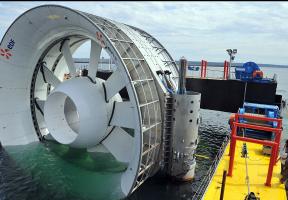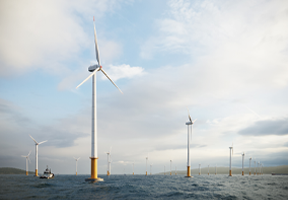Salt Water, Driving Osmotic Energy
2 min read
Using the salinity of the oceans to produce is an innovative concept that has begun to take hold in many countries. However, experiments are still in progress due to cost and efficiency considerations.

© AFP - Inauguration of the world's first osmotic power plant near Oslo in 2009 in the presence of Crown Princess.
Energy Based on the Principle of Osmosis
Osmotic uses the salt concentrated in seawater to produce electricity. The key element of this technology is a semi-permeable, double-sided membrane that lets water through but captures mineral salts. One side of the membrane is in contact with freshwater, and the other with seawater. The salt molecules attract freshwater, which migrates to the compartment containing salt water: this phenomenon is called osmosis. Driven by the movement of the water, a turbine generates power. Another technique exists, which involves the migration of positive and negative ions to create an electric current, just like in a battery. The principle of osmosis was studied at the beginning of the 1960s, to be used to demineralize seawater, and the idea of using it to produce electricity emerged in the 1970s-80s.
Facilities at River Mouths
can potentially be used in all river mouths, and the advantage is that it does not depend on weather conditions unlike wind or solar power.
Installing a power plant requires the construction of saltwater and freshwater tanks, pipelines and pumps, to carry the water supply and ensure adequate pressure, but the facilities would be smaller than those required for a hydraulic or tidal energy power plant.
The Key to Success: Efficient Membranes
The success of this technology relies on efficient membranes, usually made of cellulose acetate, which must have high resistance to wear and tear, and optimal yield. Membranes currently produce around 3 to 5 watts (W) per m2. A 2 megawatt (MW) facility, i.e. the equivalent power of an wind turbine, would require hundreds of thousands of m2 of membranes, with costs that are currently too high.
Some of the Prototypes Around the World
In 2009, Statkraft, a Norwegian company, was the first to commission a prototype of a 4kW-osmotic power plant, enough to run a washing machine. It comprised 2,000 m2 of membranes, i.e. 2W per m2 of membrane, but the experiments were put on hold in 2015, owing to a lack of market prospects.
Experiments nonetheless continue around the world, mainly in Japan and the United States. In France, Sweetch Energy has installed a demonstrator at the mouth of the Rhône, on the Barcarin lock (Port-Saint-Louis-du-Rhône). Their promoters are relying on technological breakthroughs to reduce costs, particularly those based on nanobiotechnologies.





















